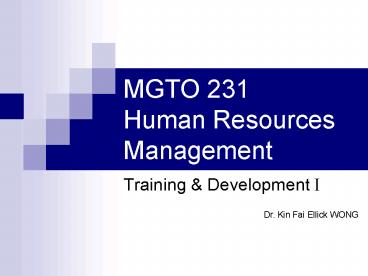MGTO 231 Human Resources Management - PowerPoint PPT Presentation
1 / 28
Title:
MGTO 231 Human Resources Management
Description:
Effort and learning do not have significant effects on ability and ... Firemen in Hong Kong. Media of training. Slides and videotapes. Teletraining. Computers ... – PowerPoint PPT presentation
Number of Views:45
Avg rating:3.0/5.0
Title: MGTO 231 Human Resources Management
1
MGTO 231Human Resources Management
- Training Development I
- Dr. Kin Fai Ellick WONG
2
Prologue
- Nature (??) vs. Nurture (??) debate
- Nature
- Ability and performance are inborn
characteristics - Effort and learning do not have significant
effects on ability and performance - Nurture
- Ability and performance are the results of effort
and learning
3
- The nature view suggests
- Recruitment and Selection is the key to make an
organization successful - More resources should be allocated to Recruitment
and Selection - The nurture view suggests
- Training and Development is the key to make an
organization successful - More resources should be allocated to Training
and Development
4
(No Transcript)
5
Strengthening human resources
- To increase person-job and person-organization
fit, two elements can be introduced after
selection - Socialization (one of the components in the
recruitment processes) - Training and development
6
- Socialization
- to shape the employees values to be consistent
with the organizations - Increases person-organization fit
- Training development
- to shape the employees skills and abilities for
the desired jobs - Increases person-job fit
7
Training vs. development
- Training
- The process of providing employees with specific
skills or helping them correct deficiencies in
their performance - Machine operations, understanding and executing
the work processes, computer programming, and use
of software, etc.
8
- Development
- An effort to provide employees with the abilities
the organization will need in the future
9
Training versus Development
Training
Development
Focus Scope Time Frame Goal
Current job Individual employees Immediate Fix
current skill deficit
Current and future jobs Work group or
organization Long term Prepare for future work
demands
Source Managing Human Resources, 4th Edition,
p.260
10
(No Transcript)
11
The training process
- General goals of training
- To increase job performance, improve morale, and
increase an organizations potential - Usually it involves three phases
- Needs assessment
- Development and conducting of training
- Evaluation
12
The Training Process
- Needs Assessment Phase
- Organization needs
- Task needs
- Person needs
- Development and
- Conduct of Training
- Location
- Presentation
- Type
Evaluation
Source Managing Human Resources, 4th Edition,
p.265
13
(No Transcript)
14
Needs assessment
- Managers determine the problems or needs that the
training must address - That is, to determine if training is needed, and
if so, to provide the information required to
design the training program - Usually involves three levels of analysis
- Organizational, task, and person
15
Levels of assessment
- Organizational analysis
- To identify both overall organizational needs and
levels of support for training - Examines broad factors such as the organizations
culture, mission, business climate, and structure - Plays a major role to determine whether training
is needed, if so, which types of training will be
offered
16
- Task analysis
- Purpose is to determine which jobs require
training - Examination of the job to be performed
- Focuses are on duties and task of jobs in the
organization (information from job analysis is
appropriate for this purpose)
17
- Person analysis
- Determines which employees need training by
examining how well employees are carrying out the
tasks that make up their jobs - Particularly, when there is employee with
performance that does not meet the standard - This information can be obtained after
performance evaluations
18
- The output of the assessment phase
- Clear and specific training objectives
- They should be challenging, precise, achievable
and understood by all - Stated in behavioral terms, and evaluations are
based on observable and measurable behaviors
19
(No Transcript)
20
The training and conducting phase
- Executing the training programs
- Training can be varied in the following
dimensions - Location of training
- Types of training
- Media of training
21
Location of training
- On the job vs. off the job
- On-the-job training
- The trainee works in the actual work setting
- Under the guidance of experienced workers,
supervisors, or trainers - Off-the-job training
- Training is conducted through other media
- Problems in skill transfer
22
Types of training
- Skills training
- Train particular skills that are important for
good job performance - see the textbook for an excellent example about
IBM telephone service - Retraining
- A subset of skill training
- It focuses on the skills employees need to keep
pace with their jobs changing requirements - E.g., new software or programming languages
23
- Cross-functional training
- Training employees to perform operations in areas
other than their assigned job - E.g., job rotation
- Team training
- Creativity training
- To improve workers innovative potential, assuming
that creativity can be learned
24
- Literacy training
- The mastery of basic skills such as reading,
writing, arithmetic, and their uses in problem
solving - Diversity training
- Teach employees about specific cultural and sex
differences - Crisis training
- Designed to deal with potential accidents
- Firemen in Hong Kong
25
Media of training
- Slides and videotapes
- Teletraining
- Computers
- Computer-aided-instruction
- Classroom instructions and role plays
26
- Simulations
- A device or situation that replicates job demands
at an off-the-job site - Virtual reality
- A kind of simulation
- Replicate the entire real-life working
environment in real time
27
(No Transcript)
28
- See the exercise

